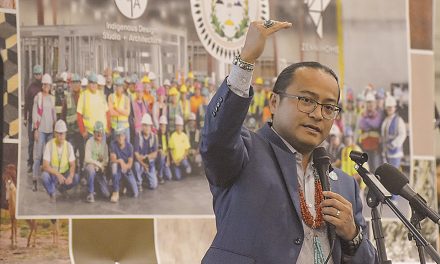
50 Years Ago: Director takes firing complaint to the Times
Over his past six-and-a-half years in office, a lot of negative things were said by various tribal leaders about the tribe’s chairman, Raymond Nakai, but the one thing he was known for was his loyalty to the people he appointed as division directors. Many of them had been vilified by delegates of the Navajo Tribal Council during his two administrations but in every case he stood by them and declared they were doing a great job.
So it came as a surprise to Dick Hardwick, the managing editor of the Navajo Times, when he learned that Wilbur Dixon had been fired on April 21 for failing to do his job. Dixon was nearing his second anniversary as director of the tribe’s Public Services Division (now called the Division of General Services). Back then, as it is now, the division dealt with the operation of the government, like overseeing tribal vehicles and keeping tribal buildings clean and safe.
But Dixon had come under fire from several members of the Council who were complaining about his supervision of the tribe’s design and construction department, which was responsible for making repairs and renovations of current tribal buildings and coming up with designs for new buildings. For the most part, this meant renovation of buildings turned over to the tribe by the Bureau of Indian Affairs because the tribe had little money to spend on new construction.
For the past few months, several members of the Council, including Annie Wauneka, had been complaining to Nakai that the design department was in a mess and employees were coming to them with complaints. Instead of sticking up for his appointee, Nakai took it seriously, possibly because it was coming from Wauneka, who had a reputation for complaining loud and long in the Council if her complaints were ignored. Just look what happened when the head of DNA, Ted Mitchell, became her enemy! He got thrown off the reservation.
It should also be mentioned that the tribe only had three divisions at the time — Administration, Resources and Public Services. Knowing the way politics within the tribal government worked then and even now, it’s likely that Wauneka had a relative working in the department who was giving her all of that inside information. Nakai, in his letter of termination for Dixon, pointed out that over the past few months, he had given him several opportunities to turn the department around and resolve the complaints coming from the staff in the department.
“I find no evidence of your ability to handle the situation effectively,” Nakai said, adding that all of the evidence indicates that morale in the department and the ability of the staff to do their job had continued to decline. “In my official capacity and moral responsibility as chairman of the Navajo Tribe, I cannot allow this situation to continue,” Nakai said.
But what made this story even more extraordinary was the fact that Dixon did not keep the firing to himself. He showed up at the Navajo Times the afternoon of his firing and told Hardwick that he was not being treated fairly by the tribe and he wanted everyone to know how he felt. He pointed out that he had gotten the message from the Council and Nakai that there were problems in the design department and that was why he fired the director of the department the week before and was then in the midst of trying to find someone who could come in and resolve the problems.
He also pointed out that he had 12 programs in his division and he didn’t have the time to actually manage the department himself. He said he did make a number of recommendations to John Scully, the former head of the department. He said as far as he could see, none of these recommendations had been carried out. Dixon told Hardwick that he blamed his firing on a lack of communication between him and Nakai.
Division directors at that time were making between $15,000 and $18,000 a year in salary. And speaking of Mitchell, although he was back working on the reservation, thanks to a federal court ruling, there was still a lot of speculation that his days as director were numbered. The Council had just a few weeks before passed s resolution calling for Nakai to accept no more funding for DNA and to try to find a different legal aid service to come in.
And while the DNA board had immediately passed a resolution supporting Mitchell, there were signs that their support may have been eroding. Seven members of the board met with members of the Council’s Advisory Committee in an effort to get them to reconsider their position. When asked by the committee how many supported Mitchell, only two raised their hands. The board consisted of 19 members, 11 of whom were Navajo.
The seven who went to the Advisory Committee meeting were all Navajo. Mitchell said he would, of course, abide by any decision the board made on his employment status but he said he wanted it to come from the entire board. The board was to meet that coming Saturday and the main item on the agenda was one continuing their support of him.
The bylaws of the program, he said, called for the director to serve at the pleasure of the board and he could be fired at any time by the board without or with a reason. But regardless of what happened at the upcoming board meeting, the group of seven accomplished their goal. The Advisory Committee voted to rescind the other resolution and asked Nakai to accept funding from the federal government for continued operation of DNA.
To read the full article, pick up your copy of the Navajo Times at your nearest newsstand Thursday mornings!
Are you a digital subscriber? Read the most recent three weeks of stories by logging in to your online account.








 Highway 264,
Highway 264, I-40, WB @ Winslow
I-40, WB @ Winslow